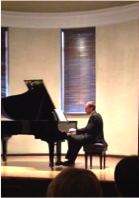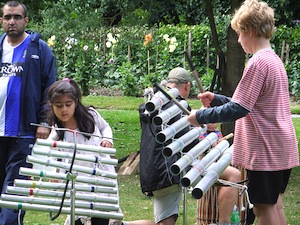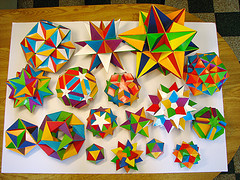Full STEAM Ahead? Rethinking Arts & STEM
A MiddleWeb Blog
I’m currently teaching a STEM/STEAM online course for Powerful Learning Practice with my arts expert buddy of 20 years – Nancy Flanagan. Our task, among other things, is to show how to put the “A” in STEM. We both have points of agreement, points of divergence, and plenty of questions.
And we’ve discovered that there are some real differences of opinion in thinking about how the Arts should be incorporated – or even if they should be incorporated.
(My alternate title for this post is: “STEAMING” STEM – Explain how, please!)
So let me run some of these ideas by you . . .
The Pure STEM Perspective. Many STEM advocates hold that the initiative was developed for one purpose: to deepen students’ understanding of fundamental concepts in science and math, and have them apply these using basic principles in engineering and technology. They have a point.
The U.S. is falling significantly behind other industrialized nations in preparing our students in the sciences and mathematics. (If you’re interested in the statistics that support this, go to Change the Equation for the details.) The 2010 College and Career Readiness report found only 43% of graduates were ready for college work in math and 29% were ready in science. And – no surprise here – business leaders are sounding alarms concerning our students’ lack of preparation for the workplace.
So, from a purist point of view, a successful STEM education provides students with science, math, and engineering/technology in sequences that build upon each other and can be used with real-world applications to provide innovative solutions to problems associated with science and technology. Adding other subjects would water down the focus on the core STEM competencies and weaken the initiative.

When we perform, when we watch, we communicate. We commune with one another, laughing together, crying together, sharing moments. We realize our feelings, our desires, our fears are not unique, we are not in this alone. And the great works of art and great artists are able to do this with a power and beauty that lifts our spirit, elevates our thinking and enriches our experiences. It’s the best part of what makes us human.
Engineering and technology can certainly serve the artist and evolve the art. But if we’re talking about how one can use art in engineering, as an artist, it seems you’re missing the point and de-valuing, or not realizing, Art’s purpose and importance. It seems you have it backwards.
The “We Need STEAM” perspective. I mentioned this dilemma to Sammy Parker (You’ll remember Sammy from his post on STE(A)M: The Important Nexus of STEM and the Arts.) who feels that a stronger alliance between the two is extremely advantageous to both. He writes, in part:

No, we don’t need a package of nifty STEAM lessons. Rather, we need to be able to teach most effectively and reach and engage students most widely in individual subjects’ core concepts–whether technological, computational, artistic, or creative. In a multidisciplinary way we need to use the elements of both STEM and art when and where they most logically relate and can assist most productively in students’ learning.
Tough? yeah. Worthwhile? Research and anecdote imply numerous positive results and possibilities, so yeah, also. Work every time? Nah; but then, what does? Enough to be educationally valuable? I think so.
The “So what do we do now?” Question
Tackling the unresolved tug-of-war between STEM and the arts has left Nancy and me struggling a bit. If we are to have STEAM in schools – and a there’s a big push for this – then what are our options? Here are four ideas we came up with:
1. You can use the STEM subjects to serve the Arts. For example, you might have kids design musical instruments to produce beautiful music. (Speaking of that, here’s a Landfill Harmonic video you don’t want to miss! Wow!)

3. You can agree to stretch the definition of engineering to include engineering the human experience. Using this approach, a dance or a musical production could be considered a product of “engineering.” This is my least favorite option because I think it weakens the STEM process. After all, to be STEAM, the engineered product (a dance, a musical production, a painting,) must use math and science in a significant way, and be tied to real math and science standards.
4. You can just keep arts and STEM separate. If you do, just know this – industrial design will be a part of STEM by default. Kids will find ways to improve the aesthetics, usability, and even the functionality of a product by using applied art. So in the end analysis, the art happens whether or not it’s intentionally planned.
My editor will definitely say I’m over the word count by now so I’ll wait until another post to blog about something I really want to clarify . . . What Isn’t STEAM? A lot of stuff flying under the STEAM banner doesn’t qualify – and the same is true for some things under the STEM banner.
Another post, for another day.
Also see Nancy Flanagan’s post “STEAM-Roller” at her Education Week Teacher blog.






























I am leaning toward Sammy’s viewpoint when he states, “In a multidisciplinary way we need to use the elements of both STEM and art when and where they most logically relate and can assist most productively in students’ learning. ” As a middle school STEM teacher, I believe that science must be taught in a multidisciplinary way and, like Sammy, feel that an effective STEM teacher will find a way to incorporate the little “a” through creative writing, representations, and more.
Thanks, Cal, for adding your thoughts. In a strictly STEM world we are working hard to increase student’s depth of knowledge and understanding in math and science, The question then arises, if we start making STEM an wider interdisciplinary focus, does that then water-down the math and science aspects? Sammy’s statement that this doesn’t have to be a zero-sum game certainly makes sense in that regard. I hope others will jump in before I say more and add their thoughts. It’s a more complicated problem than I originally anticipated.
The difference comes between integration and interdisciplinary. Integration upholds the integrity of all content areas woven together for the lesson. One is not a handmaiden to the other. By teaching and assessing concepts that apply to all content areas, students are learning more and in a more ‘real world’ atmosphere. Adults are the ones that want to separate the content into blocks of time. Authentic integration should happen regardless of STEM or STEAM.
Thank you for your thoughts – We have added the “A” to STEM – and I think of it as engaging students in STEM with intentionally developing innovators and creative problem solvers. The arts should be integrated when possible (but not forced) as demonstrated in your ideas. I also believe that arts should be embraced as its own endeavor – my own experiences with music provided me with tools to be successful in STEM.
Rather than watering anything down, using the arts in STEM should enhance student achievement! There’s nothing like a metaphor or creative representation to drive home a deeper, richer acquisition of knowledge in most any field. Imagine the impact of an exercise where students portray the effects of a scientific process (or whatever) by physically ‘acting out’ how the various elements react to each other. If my own STEM classes had included such methods of adding artistic ways of seeing scientific ideas, I would have had much greater success in those subjects.
I really enjoyed this post. As a visual art teacher, I find that other professionals want to disconnect “hard sciences” from the humanities. When they conceptualize these disciplines, they rank or sort them needlessly. Thank you for supporting the Arts as full partners in the process of improving student learning.
Well, you hit the nail on the head with that one, CManey! If we had authentic integration we probably wouldn’t be having discussions about STEM, STEAM, or any of the other initiatives being developed to try and shore up deficiencies in subject areas. Wish I knew (or somebody knew) how to change a status-quo school culture to allow for such subject integration. (Self-contained elementary teachers might come the closest to being able to truly integrate curriculum in our current classroom settings.) Right now, “interdisciplinary” is what generally winds up happening. Thanks for the clarification.
A portion of this discussion should come back to the learners and what they want to learn. We can still teach for standards but should reflect first on what students want to know and focus attention accordingly. If all students are required to have arts credits for graduation purposes, shouldn’t they have a say in what they must learn to earn said credits? If they enter a prescripted curriculum then the “a” is forced and consider the small percentage of students who actually choose to make art a chosen path or career. If students intend to follow a STEM path, then true integration of the “a” into STEM should be a prerequisite.
I like to say that one important thing the A brings into STEM is also Accessibility. I consider the STEM/STEAM movements in education to be important because they will reach students whose families are not involved in STEM careers, and therefore may not be considering majoring or working in STEM fields. However, those families often view each of the STEM elements to be intimidating – something they aren’t familiar with, and can’t provide advice or homework help with. By adding art into the mixture, it provides a path in, that parents and students can be more comfortable with, and pulls STEM out of the domain of scientists and mathematicians and engineers.
I am not an educator, but a parent who works in a career that is arguably STEAM (I design videogames), and so I consider STEAM to be a better representative of the real world than STEM in many ways. Integrating the arts into STEM can be a kind of template for creativity too. Not that there isn’t creativity in real-world STEM of course! But I sometimes see STEM education that does leave creativity out of the equation – it becomes a “follow the instructions” exercise, where everyone makes the same thing and solves the problem the same way. This is easier to design, but doesn’t ring true to that real-world problem-solving experience that everyone is trying to introduce into schools. I think that STEAM more naturally suggests that projects should be less rigid and more creative, so there is benefit in keying into that perception right from the start.
[posted by Susan Curtis for Anne]
So many good comments and ideas! I’d like to throw out a couple of ideas myself here. True STEM is indeed a creative approach to problem solving that teaches many “soft skills” students need in the workforce. Of course, If I understand one of Jo’s points, it’s not exactly implemented with fidelity in all situations. (“follow the instructions?” Shudder!) I’ll bet if we all put our heads together we could come up with two dozen or more different initiatives that fly under the banner of STEM. Some of them involve simply adding an advanced math or science course. Is that STEM? .
And – let’s suppose we decide to leave the “A” out of STEM. How is that even possible? If a student team designs a rocket car or a line of make-up, do they want those products to be ugly? So, do we need art to be a part of the process from the beginning and in a more intentional way? Believe me, art (in some form) will be there as a de facto part of STEM.
Loving your comments!
Anne
Thanks, Susan, for posting that reply for me. My computer was doing it’s “glitch” thing. I wanted to ask Hilary if she would briefly explain HOW they added the “A” to STEM. The rationale seems obvious. The lessons that actually do that are more difficult. I find that many lessons seem to either ignore the math and science, or they use art in a very surface manner as decoration only. If any one has thoughts on this, please jump in. It’s a matter of real interest and need.
I am sorry not to have encountered this discussion earlier. I am a teacher of woodworking in lower and middle school grades (27 yrs), but have a background in arts, music (conservatory graduate and performer of chamber music and soloist), and in science and mathematics, both of which I taught at an elementary level in my present school. I recently attended a STEAM conference in NY State, which i found to be rewarding and validating. I found this blog by typing the question, “How did Art become added to STEM?”
I have one observation regarding artistic expression. It involves thinking, sometimes in ways that non-artists and even some artists might not recognize as such. The mind/body/brain is a complex of feedback systems that are constantly communicating and furiously cross-checking information, unconsciously and consciously, and not all of its modes are completely understood. Creativity in the brain is evidently especially enigmatic. Unselfconscious creative expression of questions and emotions regarding any kind of concept, when legitimately rewarded with recognition and honor, is evidently, however, a powerful source of self-confidence, including in one’s ability to think well. The views expressed by the music students in “Landfill Philharmonic” are manifestations, and there are countless other examples.
Thanks. I will try to visit more frequently from now on.
Thanks for your visit and for your interest in arts and STEM, Gary. I watched the “Landfill Philharmonic” and was blown away! Thanks for mentioning it. For readers who haven’t seen this, here’s a video worth watching! You can google it or go to this address: http://bit.ly/KFn4AB
I agree completely about the amount of thinking involved in the arts. The myriad of neural connections that must work cooperatively and simultaneously to play a piano sonata must be jaw-dropping! When teaching, I found my artistic students to have really stimulating and thought-provoking solutions for problems. They also ask amazingly insightful questions.
I believe in STEAM it is really awesome and it brings STEM to life
Hi, David! I’m so glad you dropped by to say that. If you have some experience with STEAM maybe you can tell us how it’s going.
I was hired to teach a Music+STEM class that has evolved into a Music+. I’m lucky to have a principal who embraces integration. While music provides the core of my curriculum I’m able to go in any direction that I want to in order to learn about naturally occurring topics, i.e. Music & the brain, the elements of music used to create streaming channels, creating music with tech, etc. When we’re not so concerned with the silos of subjects – or creating neat collections of silos- it’s not difficult to create authentic learning for students.
Your last sentence makes me smile ear to ear, Mindy. And congrats on being a music teacher! I read an article last week on the connection between kids brains and music … music is part of our very being. Thank you for integrating it with other areas such as STEM.